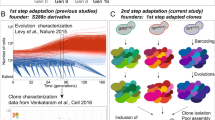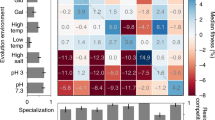Abstract
An evolutionary capacitor buffers genotypic variation under normal conditions, thereby promoting the accumulation of hidden polymorphism. But it occasionally fails, thereby revealing this variation phenotypically1. The principal example of an evolutionary capacitor is Hsp90, a molecular chaperone that targets an important set of signal transduction proteins. Experiments in Drosophila and Arabidopsis have demonstrated three key properties of Hsp90: (1) it suppresses phenotypic variation under normal conditions and releases this variation when functionally compromised; (2) its function is overwhelmed by environmental stress; and (3) it exerts pleiotropic effects on key developmental processes1,2. But whether these properties necessarily make Hsp90 a significant and unique facilitator of adaptation1,2,3,4,5,6,7,8,9,10 is unclear. Here we use numerical simulations of complex gene networks, as well as genome-scale expression data from yeast single-gene deletion strains, to present a mechanism that extends the scope of evolutionary capacitance beyond the action of Hsp90 alone. We illustrate that most, and perhaps all, genes reveal phenotypic variation when functionally compromised, and that the availability of loss-of-function mutations accelerates adaptation to a new optimum phenotype. However, this effect does not require the mutations to be conditional on the environment. Thus, there might exist a large class of evolutionary capacitors whose effects on phenotypic variation complement the systemic, environment-induced effects of Hsp90.
This is a preview of subscription content, access via your institution
Access options
Subscribe to this journal
Receive 51 print issues and online access
$199.00 per year
only $3.90 per issue
Buy this article
- Purchase on Springer Link
- Instant access to full article PDF
Prices may be subject to local taxes which are calculated during checkout


Similar content being viewed by others
References
Rutherford, S. L. & Lindquist, S. Hsp90 as a capacitor for morphological evolution. Nature 396, 336–342 (1998)
Queitsch, C., Sangster, T. A. & Lindquist, S. Hsp90 as a capacitor of phenotypic variation. Nature 417, 618–624 (2002)
Cossins, A. Cryptic clues revealed. Nature 396, 309–310 (1998)
Dickinson, W. J. & Seger, J. Cause and effect in evolution. Nature 399, 30 (1999)
McLaren, A. Too late for the midwife toad: Stress, variability and Hsp90. Trends Genet. 15, 169–171 (1999)
Wagner, G. P., Chiu, C.-H. & Hansen, T. F. Is Hsp90 a regulator of evolvability? J. Exp. Zool. 285, 116–118 (1999)
Rutherford, S. L. From genotype to phenotype: buffering mechanisms and the storage of genetic information. BioEssays 22, 1095–1105 (2000)
Pigliucci, M. Developmental genetics: buffer zone. Nature 417, 598–599 (2002)
Mitchell-Olds, T. & Knight, C. A. Chaperones as buffering agents? Science 296, 2348–2349 (2002)
Meiklejohn, C. D. & Hartl, D. L. A single mode of canalization. Trends Ecol. Evol. 17, 468–473 (2002)
Scharloo, W. Canalization: Genetic and developmental aspects. Annu. Rev. Ecol. Syst. 22, 65–93 (1991)
Gibson, G. & Wagner, G. Canalization in evolutionary genetics: A stabilizing theory? BioEssays 22, 372–380 (2000)
Waddington, C. H. Canalization of development and the inheritance of acquired characters. Nature 150, 563–565 (1942)
Siegal, M. L. & Bergman, A. Waddington's canalization revisited: Developmental stability and evolution. Proc. Natl Acad. Sci. USA 99, 10528–10532 (2002)
Wagner, A. Does evolutionary plasticity evolve? Evolution 50, 1008–1023 (1996)
Featherstone, D. E. & Broadie, K. Wrestling with pleiotropy: Genomic and topological analysis of the yeast gene expression network. BioEssays 24, 267–274 (2002)
Ravasz, E., Somera, A. L., Mongru, D. A., Oltvai, Z. N. & Barabási, A.-L. Hierarchical organization of modularity in metabolic networks. Science 297, 1551–1555 (2002)
Wagner, G. P., Booth, G. & Bagheri-Chaichian, H. A population genetic theory of canalization. Evolution 51, 329–347 (1997)
Winzeler, E. A. et al. Functional characterization of the S. cerevisiae genome by gene deletion and parallel analysis. Science 285, 901–906 (1999)
Hughes, T. R. et al. Functional discovery via a compendium of expression profiles. Cell 102, 109–126 (2000)
Giaever, G. et al. Functional profiling of the Saccharomyces cerevisiae genome. Nature 418, 387–391 (2002)
Stearns, S. C., Kaiser, M. & Kawecki, T. J. The differential genetic and environmental canalization of fitness components in Drosophila melanogaster. J. Evol. Biol. 8, 539–557 (1995)
Rice, S. H. The evolution of canalization and the breaking of von Baer's laws: Modeling the evolution of development with canalization. Evolution 52, 647–656 (1998)
Wagner, G. P. & Mezey, J. Modeling the evolution of genetic architecture: A continuum of alleles model with pairwise A × A epistasis. J. Theor. Biol. 203, 163–175 (2000)
Hansen, T. F. & Wagner, G. P. Modeling genetic architecture: A multilinear theory of gene interaction. Theor. Popul. Biol. 59, 61–86 (2001)
Edwards, R. J. & Brookfield, J. F. Y. Transiently beneficial insertions could maintain mobile DNA sequences in variable environments. Mol. Biol. Evol. 20, 30–37 (2003)
Tautz, D. A genetic uncertainty problem. Trends Genet. 16, 475–477 (2000)
Acknowledgements
We thank B. Baker, D. Hartl, J. Hermisson, D. Kennedy, J. Masel, C. Meiklejohn, D. Petrov, G. Wagner, C. Yanofsky and E. Zuckerkandl for helpful discussions. This study was supported by the Center for Computational Genetics and Biological Modeling, Stanford University. M.L.S. was supported by a National Institutes of Health National Research Service Award Individual Postdoctoral Fellowship, and thanks B. Baker for his support. A.B. thanks the Paul G. Allen Charitable Foundation for its continual support.
Author information
Authors and Affiliations
Corresponding author
Ethics declarations
Competing interests
The authors declare that they have no competing financial interests.
Rights and permissions
About this article
Cite this article
Bergman, A., Siegal, M. Evolutionary capacitance as a general feature of complex gene networks. Nature 424, 549–552 (2003). https://doi.org/10.1038/nature01765
Received:
Accepted:
Issue Date:
DOI: https://doi.org/10.1038/nature01765
This article is cited by
-
Plasticity-led evolution as an intrinsic property of developmental gene regulatory networks
Scientific Reports (2023)
-
Robust morphogenesis by chaotic dynamics
Scientific Reports (2023)
-
Co-expression network analysis of environmental canalization in the ascidian Ciona
BMC Ecology and Evolution (2022)
-
Differential effects of steroid hormones on levels of broad-sense heritability in a wild bird: possible mechanism of environment × genetic variance interaction?
Heredity (2022)
-
Rethinking the Architecture of Attachment: New Insights into the Role for Oxytocin Signaling
Affective Science (2022)
Comments
By submitting a comment you agree to abide by our Terms and Community Guidelines. If you find something abusive or that does not comply with our terms or guidelines please flag it as inappropriate.



